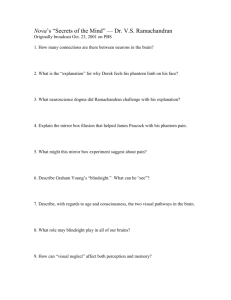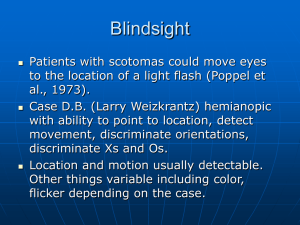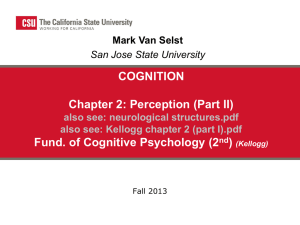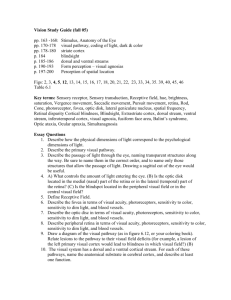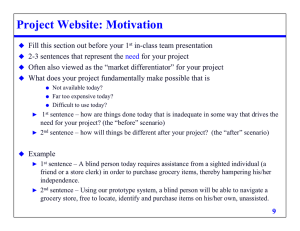neuroscience
advertisement
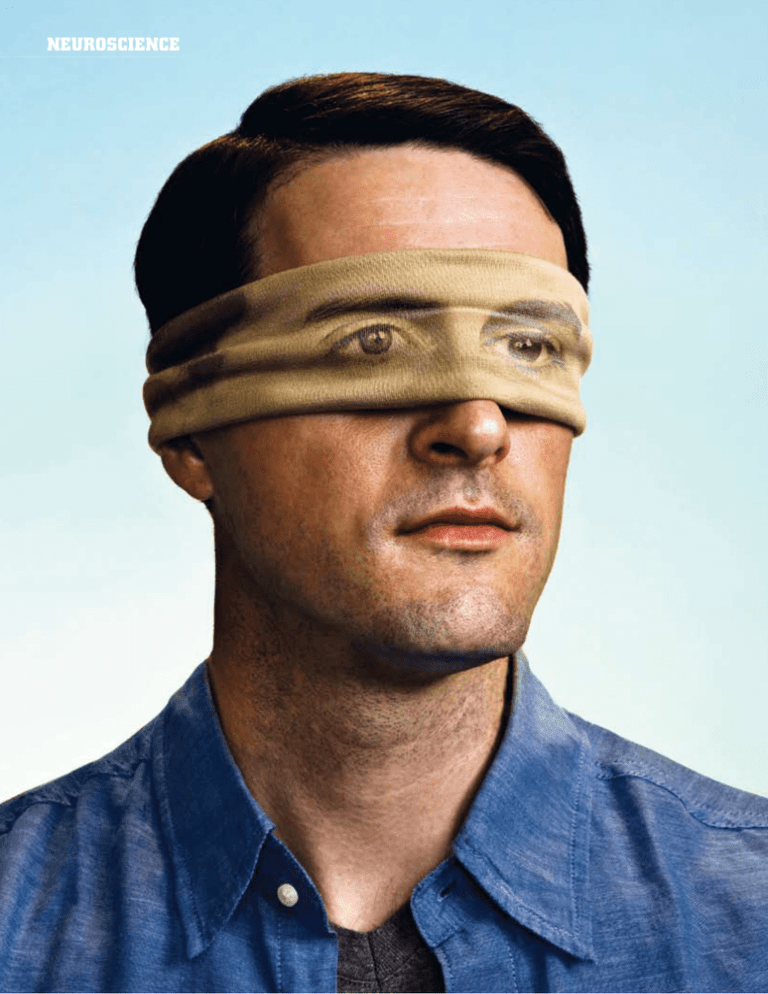
neuroscience Uncanny sight in the Blind Some people who are blind because of brain damage have “blindsight”: an extraordinary ability to react to emotions on faces and even navigate around obstacles without knowing they can see anything By Beatrice de Gelder darren braun T he video my colleagues and I shot is amazing. A blind man is making his way down a long corridor strewn with boxes, chairs and other office paraphernalia. The man, known to the medical world as TN, has no idea the obstacles are there. And yet he avoids them all, here sidling carefully between a wastepaper basket and the wall, there going around a camera tripod, all without knowing he has made any special maneuvers. TN may be blind, but he has “blindsight”— the remarkable ability to respond to what his eyes can detect without knowing he can see anything at all. [To see the film of the experiment, go to www.ScientificAmerican. com/may2010/blindsight.] TN’s blindness is of an extremely rare type, caused by two strokes he suffered in 2003. The strokes injured an area at the back of his brain called the primary visual cortex, first on his left hemisphere and five weeks later on the right. His eyes remained perfectly healthy, but with his visual cortex no longer receiving the w w w. S c i e n t i f i c A m e r i c a n . c o m incoming signals he became completely blind. This study of TN navigating along the hallway is probably the most dramatic demonstration of blindsight ever reported. Other patients who have lost vision because of damage to the primary visual cortex have exhibited less spectacular but equally mysterious cases of the phenomenon — responding to things they cannot consciously see, ranging from simple geometric shapes to the complex image of a person’s face expressing an emotion. Scientists have also induced a similar effect in healthy people, by temporarily “switching off” their visual cortex or by outfoxing it in other ways. Today research into blindsight seeks to understand the range of perceptual abilities that may be retained by the cortically blind and to determine which brain regions and neuronal pathways are responsible. The knowledge being gained says something about us all, because even if we never suffer a catastrophic injury resembling TN’s, the same unconscious brain Key Concepts ■■ ■■ ■■ Some people who are blind because of brain damage exhibit “blind­ sight”—responses to objects and images they cannot consciously see. Blindsight can detect many visual features, including colors, motion, simple shapes, and the emotion expressed by a person’s face or posture. Researchers are mapping the ancient brain areas responsible for blindsight and exploring the limits of this remarkable ability. —The Editors SCIENTIFIC AMERICAN 61 [BASICS] What Is Blindsight? Conscious vision in humans depends on a region of the brain called the primary visual cortex (below). Damage there causes blindness in corresponding areas of the visual field. “Blindsight” occurs when patients respond in some way to an item displayed in their blind area, where they cannot consciously see it. In a dramatic demonstration of the phenomenon, a patient called “TN” navigated an obstacle course despite his total blindness (right). Visual Pathways Right visual field Signals from the retina go to the primary visual cortex via the lateral geniculate nucleus in the midbrain and ultimately to higher areas for conscious processing. Nerves also send visual information to areas such as the pulvinar nucleus and superior colliculus in the midbrain. Those areas do not seem to produce any conscious vision, but some must underlie blindsight. Blind area Nerves Left visual field Damage Retina Primary visual cortex Pulvinar nucleus Lateral geniculate nucleus Superior colliculus functions manifest in him as the astonishing ability to see without knowing are surely a constant, invisible part of our own daily existence. A Controversial History It is now clear that many more patients with damage to the visual cortex have blindsight than scientists realized in the past. 62 S cientific A merican As long ago as 1917, doctors reported cases like blindsight— then called residual vision— in soldiers injured in World War I. Half a century would pass, however, before more organized and objective research into the capacity began. First, Lawrence Weiskrantz and his student Nicholas K. Humphrey, both then at the University of Cambridge, studied surgically altered monkeys in 1967. Then, in 1973, Ernst Pöppel, Richard Held and Douglas Frost of the Massachusetts Institute of Technology measured the eye movements of a patient and found he had a slight tendency to look toward stimuli that he could not see consciously. These discoveries spurred further systematic investigations of animals lacking the primary visual cortex (also called V1), most of them conducted by Weiskrantz and his collaborators. A number of studies established that animals retain significant visual abilities after removal of their visual cortex (for example, detecting movement and discriminating shapes). Weiskrantz and his co-workers also began studies in 1973 with a person known as DB who had recently lost part of his visual cortex in sur- Navigating Blind Suspecting patient TN might exhibit blindsight, researchers, including Lawrence Weiskrantz (shown with TN above), asked him to walk down a cluttered hallway, telling him it was empty. TN avoided all the obstacles, even though he remained unaware of them and of his meandering path. Video of the experiment is online at www.ScientificAmerican.com/may2010/blindsight. gery to remove a tumor. The wider research community, however, initially greeted reports of human blindsight with great skepticism. Disbelief about blindsight is not surprising, because the phenomenon seems counterintuitive, if not outright contradictory. After all, how could people see without knowing that they see? Just as it does not make sense to say that I do not know if I am in pain, it also does not make sense, on the face of it, to suggest that somebody can see something when he insists he is blind. Yet we do not always know that we can see. Nor do we always know that we cannot. The relation between seeing and knowing is more complicated than we commonly assume. For instance, people with normal sight have a blind spot, although we are not usually aware of this hole in our sight or handicapped by it. Another reason for disbelief was the paucity of human evidence: subjects with cortical blindness who can be studied are rare. The primary visual cortex is only a few centimeters across in adults, and brain damage is seldom restricted to just that area, knocking out the patient’s vision yet leaving other faculties intact enough for meaningful research on what the brain continues to perceive. Even so, it is now clear that many more patients with damage to the visual cortex have blindsight than scientists realized in the past, and skepticism has abated. M a y 2 0 10 keith kasnot (illustration); beatrice de gelder (photograph) Light Anthony Marsland Getty Images (happy); getty images (sad) Most of these patients still have some functioning in the primary visual cortex. Many have damage to only a small part of V1, leading to a small island of blindness in their visual field; others lose the entire left or right half of V1, leaving them blind across the corresponding (opposite) half of their visual field. Blindsight in these cases involves detecting objects or images presented in the blind area, where the patient cannot see them consciously. Traditional methods for studying vision in humans have relied on the viewers’ verbal reports of what they perceive. Tested in that way, subjects will report not seeing anything in the blind part of their visual field. More indirect methods, however, can reveal that these unseen visual stimuli actually do influence how a patient responds. In some experiments, patients show clear physiological changes, such as constriction of the pupil, as signs of unconscious seeing. And subjects can react differently to items shown in the intact visual field depending on what is presented at the same time in the blind field. When asked to guess which of several alternative items are displayed in the blind field, a patient may answer correctly almost every time. Another important experimental tool is neuroimaging, which can provide direct evidence about the brain regions involved in blindsight and the pathways that the visual information travels. Brain imaging has been instrumental in dispelling lingering suspicions that some spared pieces of cortex might explain residual vision. Collectively, these various kinds of experiments have revealed that people can unconsciously detect a wide range of visual attributes, including color, simple shapes such as X and O, simple motion, and the orientation of lines or gratings. Large shapes, as well as very fine detail, seem hard to detect. For instance, patients detect features of a grating most effectively if its lines are comparable to venetian blinds viewed from about 1.5 to 4.5 meters (five to 15 feet). We were inspired to try the navigation experiment with TN by research Weiskrantz and Humphrey did in the 1970s: a monkey with no primary visual cortex freely moved around a room cluttered with objects without bumping into any of them. Nevertheless, we were amazed when TN made his way along the hallway with no collisions at all. Personalized psychophysical tests to assess his conscious vision had not found any visual functioning, including detection of big targets. TN’s ability to move down the corridor was w w w. S c i e n t i f i c A m e r i c a n . c o m What can be detected? Blindsight is strongest when visual details are about the size of a quarter viewed from five to 15 feet away. It can detect an assortment of basic visual properties, including: ■ Simple shapes ■ Arrays of lines ■ Objects appearing or disappearing ■ Movement ■ Color ■ Orientation of lines Blindsight can also recognize emotions being expressed by a person, but not who the person is or the person’s gender. reminiscent of sleepwalking, another phenomenon in which people exhibit a capacity to perform in some way without having any awareness of their actions. Indeed, when we questioned him afterward, he insisted he had simply walked along the hallway: he was not only unaware of seeing anything but also oblivious to how he had maneuvered around the unseen objects. He was at a loss to explain or even to describe his actions. Blindsight for Emotions Moving around is one of the most fundamental tasks an animal faces, so perhaps it should not be surprising that the brain has ways to support navigation even when the primary visual cortex and conscious vision are hobbled. As a social species, humans also depend for their survival on successful communication with others. They must recognize other people, along with their gestures and signs of what they are thinking. With such thoughts in mind, my collaborators and I began to wonder in the late 1990s if people with cortical damage could detect visual displays such as the emotion on a face or the meaning of a body posture in the usually inaccessible parts of their visual field. In 1999 we started conducting tests using movies of faces. Vision researchers generally consider faces to be visually complex— far more difficult to process than gratings and other elementary shapes — but a face is a very natural form for the human brain to handle. Our patient, GY, had lost all of his primary visual cortex on the left side in childhood, rendering him blind on the right side of his visual field. We found he could reliably guess the expression appearing on faces he did not consciously perceive, but he seemed truly blind to a variety of nonemotional facial attributes such as personal identity and gender. To study blindsight of emotions further, in 2009 we exploited a phenomenon called emotional contagion, a tendency to match one’s own facial expressions to those of others that we see. Researchers measure emotional contagion with a procedure called facial electromyography, by which electrodes on a subject’s face record nerve signals going to muscles involved in smiling or frowning. We used this technique on GY and DB while showing them still images of faces and whole bodies expressing happiness or fear. All the stimuli triggered emotional reactions as measured by electromyography, irrespective of whether the image was on the patient’s sighted side or his blind side. In fact, surprisingly, the SCIENTIFIC AMERICAN 63 [EXPERIMENTS] Investigating Blindsight Because total cortical blindness like patient TN’s is rare, studies of blindsight often use patients blind on one side of their visual field. The patient stares at a fixed point while imag­ es are presented on each side. The subject may be asked to “guess” what is on the blind side or to press a button on seeing items on the sighted side. Equipment may monitor brain activity and measure involuntary responses such as tiny facial movements and pupil dilation. Does Blindsight See Emotions? Normal sight Small contraction Blind side Sighted side Blindsight Large contraction Normal sight Small contraction No blindsight Small contraction Patients shown images on their blind side of people expressing emotions correctly guessed the emotion most of the time. Facial muscles used in smiling and frowning reacted in ways that matched the kind of emotion in the unseen image (below, exaggerated). Thus, the emotions were recognized without involv­ ing conscious sight. The effect worked with images of faceless bodies as well as faces, implying that patients were recognizing an emotion and not merely mimicking a facial expression unconsciously. Patient with blindsight Sighted side ▲ hat W Electrodes measuring facial movements Mapping neural pathways Researchers are using advanced imaging techniques to attempt to trace the neural pathways that visual information travels in the brain to produce blindsight. One such method is a kind of magnetic resonance imaging called diffusion tensor imaging, which relies on water diffusing more rapidly along neurons than across them. Diffusion tensor imaging has mapped bundles of neurons that may be responsible for blindsight of emotions. The pathway connects the pulvinar nucleus and superior collicu­ lus to the amygdala, which plays a key role in processing emotions. 64 S cientific A merican unseen images produced a faster response than those seen consciously. We also monitored pupil dilations, a measure of physiological arousal. The unseen fearful images produced the strongest effect — seemingly the more we are consciously aware of an emotional signal, the slower and weaker is our reaction. One school of thought holds that emotional contagion arises because people unconsciously mimic the expressions they see, without necessarily recognizing the emotion itself. But because our patients reacted not only to faces but also to bodies (which had blurred faces), we concluded that they were perceiving and responding to the emotion. Blindsight for All Because the number of suitable patients for blindsight studies is extremely small, inducing the phenomenon temporarily in people with completely healthy brains is a valuable tool for conducting controlled experiments. One technique uses visual “masking,” more popularly Brain Areas Does Blindsight Use? Researchers showed patients gray and purple squares, knowing the superior colliculus region in the midbrain receives no signals from the retina about purple objects. Gray squares but not purple ones triggered signs of blindsight such as greater pupil contractions. These results, along with neuroimaging of the patients in action, imply that the superior colliculus plays a critical role in blindsight. known as the use of subliminal images: a visual stimulus flashes before the experimental subject very briefly, followed immediately by a pattern in the same location. The pattern interferes with conscious processing of the fleeting subliminal image, leaving the subject with no conscious awareness of seeing it, but experiments can tease out objective evidence that it was seen. Other experiments temporarily disable the visual cortex by applying magnetic fields to the back of the head, a technique called transcranial magnetic stimulation. Numerous studies have shown that healthy subjects can reliably “guess” the nature of a stimulus even when it is presented too briefly for them to perceive it consciously or when transcranial magnetic stimulation is disabling their visual cortex. Much research has also investigated how normally sighted observers react to emotional stimuli they cannot see consciously. Even before such blindsight experiments got under way, studies in animals and humans suggested that structures in the subcortex (areas of the M a y 2 0 10 keith kasnot (experiment and eyes); lucy reading-ikkanda (squares) de Blind si brain that are deeper and more evolutionarily ancient than the cortex) can initiate appropriate responses before areas such as the visual cortex have analyzed the stimulus in detail. This nonconscious system seems to operate in parallel with the normal, predominantly cortical, processing routes. These subcortical areas that are activated by subliminal emotional stimuli are the leading suspects in processing emotions detected by blindsight in permanently blind patients. Yet scientists continue to debate whether these temporary forms of blindness induced in normally sighted people are the true functional equivalent of blindsight in patients with permanent cortical damage. In particular, visual-masking techniques, such as the use of subliminal images, permit the visual cortex to process information as usual but interfere with further conscious processing. Consequently, “blindsight” of subliminal images could be a quite distinct phenomenon from blindsight in patients, involving its own characteristic assortment of brain regions. Trans­ cranial magnetic stimulation presumably mimics cortical damage closely, but to know whether the resulting blindsight actually involves the same neuronal pathways requires experiments that combine the technique with neuroimaging. Conversely, after an injury, a patient’s brain (even an adult’s) may start rewiring itself to compensate for the loss. Such neural plasticity could well create pathways for blindsight that are not present in the normally sighted people who are studied using transcranial magnetic stimulation and visual masking. Until these issues are better understood, studies of patients with injuries will remain crucial for fathoming how noncortical regions produce residual vision. courtesy of m. kret Neural Pathways Research has not yet fully determined the neural structures responsible for blindsight in the cortically blind, but the most likely candidate to play a central role is a brain region called the superior colliculus (SC), which sits in a part of the subcortex called the midbrain. In nonmammals such as birds and fish, the SC is the main structure receiving input from the eyes. In mammals it is overshadowed by the visual cortex but remains involved in controlling eye movements, among other visual functions. Blindsight would exploit information that travels from the retina to the SC without first going through the primary visual cortex. Last year my colleagues and I showed that this midbrain area is essential for translating a w w w. S c i e n t i f i c A m e r i c a n . c o m [The Author] Beatrice de Gelder is professor of cognitive neuroscience and director of the Cognitive and Affective Neuroscience Laboratory at Tilburg University in the Netherlands. She is also on the faculty of the Athinoula A. Martinos Center for Biomedical Imaging in Charlestown, Mass. De Gelder investigates the neuroscience behind processing of faces and emotions and the ways cognition and emotion interact in both healthy and damaged brains. ➥ More To Explore Unseen Facial and Bodily Expressions Trigger Fast Emotional Reactions. Marco Tamietto et al. in Proceedings of the National Academy of Sciences, Vol. 106, No. 42, pages 17661–17666; October 20, 2009. Collicular Vision Guides Nonconscious Behavior. Marco Tamietto et al. in Journal of Cognitive Neuroscience, Vol. 22, No. 5, pages 888–902; May 2010. Affective Blindsight. Beatrice de Gelder and Marco Tamietto in Scholarpedia, Vol. 2, No. 10, page 3555; 2007. Available at www. scholarpedia.org/article/ Affective_blindsight Helen, a Blind Monkey Who Sees Everything. Video from 1971. Avail­ able at bit.ly/blindsightmonkey visual signal that cannot be consciously perceived into an action. Specifically, we had a patient press a button whenever we showed him a square on his sighted side. Sometimes we simultaneously presented a square on his blind side. Sometimes we used gray squares and sometimes purple ones. We chose a purple hue that only one type of light-detecting cone cell in the retina detects, knowing that the SC receives no inputs from that type; it is blind to this purple. A gray square on our patient’s blind side accelerated his response and made his pupils constrict more — a sign of processing the stimulus — whereas a purple square had neither effect. In other words, he exhibited blindsight of gray stimuli but not purple ones. Brain scans showed that his SC was most strongly activated only by the gray stimulus on his blind side. Some other areas in the midbrain have been suspected of being involved in blindsight instead of the SC, but in our experiment their activity seemed unrelated to the occurrence of blindsight. These findings show that the SC acts in the human brain as an interface between sensory processing (sight) and motor processing (leading to the patient’s action), thereby contributing to visually guided behavior in a way that is apparently separate from the pathways involving the cortex and entirely outside conscious visual experience. Blindsight of emotions displayed by people also involves the SC as well as other areas in the midbrain, such as the amygdala. Blindsight has captured a lot of attention from philosophers, who are intrigued by the paradoxical idea of seeing without knowing that one sees. The idea, of course, is only a paradox if “seeing” is always taken to mean “consciously seeing.” That mind-set was a stumbling block to acceptance of blindsight by scientists, delaying progress in understanding the role of unconscious seeing in human cognition. It can also be a stumbling block for patients suffering from cortex-based loss of vision, preventing them from unlocking the potential of their residual visual skills in their everyday lives. For example, TN views himself as a blind person, and he will remain totally dependent on his white cane until he is convinced he can see without knowing it. Training may also help. After three months of daily stimulation, cortically blind patients were better at detecting targets in their blind field. Whether training in realistic conditions could lead to improved navigation skills is, like so many other features of blindsight, a question for future research. ■ SCIENTIFIC AMERICAN 65
